 |

| |
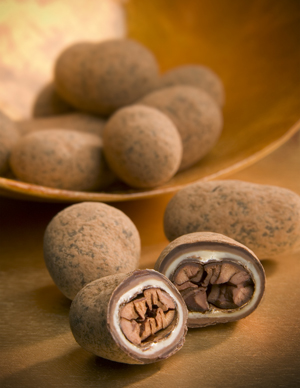
Nibs, chocolate and cocoa powder: all types of chocolate in one delicious bite. Photos by Kent Lacin. |
| WHAT IT IS: Cacao (cocoa) beans, roasted and enrobed in three layers of El Rey chocolate and dusted with cocoa powder. |
| WHY IT’S DIFFERENT: There are chocolate-covered cacao beans, but none like these artistic renditions. These crunchy gourmet nuggets are addictive. There are five flavors of chocolate in each bite. |
| WHY WE LOVE IT: A gourmet experience—intense layers of chocolate. Experience chocolate in its three major forms and textures—the cacao bean, including the nibs, plus finished chocolate and cocoa powder. |
| WHERE TO BUY IT: CocoaPuro.com. |
|
|
 |

Cocoa Puro:
Kakawa Cocoa Beans
CAPSULE REPORT: Here’s a concept: Take the venerable cacao bean, mother of all chocolate. Roast it until crunchy, because people love crunchy snacks. Then enrobe it in all three types of chocolate (white, milk and dark), and roll the chocolate-covered bean in cocoa powder. Suddenly, you have a unique, five-in-one chocolate experience—all of the manifestations of cacao in one bite.
Tom Pedersen was looking to do something new and different with the best quality ingredients when he created Kakawa Cocoa Beans. The result is an intense nugget of chocolate flavors, with hints of nuts, fruits, earthiness, woodiness and wonder. If you like chocolate-covered coffee beans, you will certainly cotton to Kakawa. Instead of the acidity of coffee beans, they deliver round cacao bean flavor. They are divine with after-dinner coffee and liqueurs, or as an anti-oxidant snack.
Kakawa is the first-known word for cacao, used by the Olmec civilization, the earliest cultivators of the plant. They ground the beans and whipped them into a frothy but intensely-strong beverage; then taught this to the Mayas, who taught it to the Aztecs. For chocolate lovers who like strong flavor and texture, this cacao is puro, indeed. Read the full review below.
|
THE NIBBLE does not sell the foods we review
or receive fees from manufacturers for recommending them.
Our recommendations are based purely on our opinion, after tasting thousands of products each year, that they represent the best in their respective categories. |
More Great Chocolate
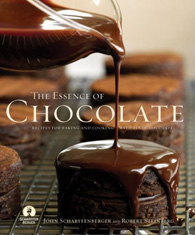 |
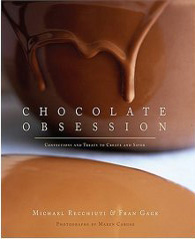 |
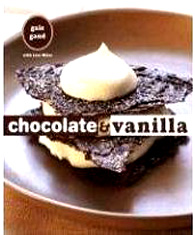 |
| Essence of Chocolate: Recipes for Baking and Cooking with Fine Chocolate, by John Scharffenberger and Robert Steinberg. America’s preeminent maker of gourmet baking chocolate launches its first cookbook, with more than 100 recipes for classics as well as Chocolate Chunk Challah, a homemade version of Oreos and savory dishes made with chocolate like Tortilla Soup and Chile-Marinated Flank Steak. Click here for more information. |
Chocolate Obsession: Confections and Treats to Create and Savor, by Michael Recchiuti and Fran Gage. The top chocolatier makes it possible for amateurs to achieve his artistry in dipped chocolates, truffles and molded chocolates. With his recipes for Earl Grey tea, burnt caramel and tarragon with grapefruit ganaches, plus some delicious baked goods (Recchiuti is also a pâtissier), this book provides many hours of happiness. Click here for more information. |
Chocolate and Vanilla, by Gale Gand. James Beard Award-winner Gand, host of the Food Network’s Sweet Dreams and co-owner and Executive Pastry Chef at Chicago’s Tru, dazzles as usual. Recipes are both delicious and visually arresting. Those who are chocoholics may discover their inner vanilla in this book, which gives equal attention to the spice that Gand considers even sexier than chocolate. Click here for more information. |
Cocoa Puro: Kakawa Cocoa Beans
INDEX OF REVIEW
|
MORE TO DISCOVER
|
Some chocolatiers have vast lines, like Michael Recchiuti: bonbons, nuts, pâtes de fruits and all sorts of confections. Some, like Christopher Elbow, make a box of filled chocolates and, more recently, a custom blend of cocoa powder, but that’s it. Then there are specialist confectioners like Tom Pedersen of Cocoa Puro in Austin, Texas, who make just one item: Kakawa Cocoa Beans.
Tom liked chocolate, and like many serious chocolate lovers, he invested his leisure time learning about it—not just about the different types of chocolate, but about the origin of chocolate and the pre-Colombian cultures that worshipped it—the Olmecs, the Mayas and the Aztecs. Immersed in the study of chocolate, he realized he wanted to do something new and unique with it, and he began to focus on the most basic element, the bean. Today, it’s a lot easier to find packaged cacao beans and nibs at health food stores and boutique chocolatiers. But when Pedersen began, it took a while to find a source for raw cacao beans so he could get to work in his home kitchen, teaching himself to roast the beans and coat them with chocolate. He chose the best beans: Criollo beans, the top 5% of the world’s crop, and Trinitario beans, the top 10% to 15%. (To learn more about them, see our Chocolate Glossary.)
The beans are the result of painstaking labor. After hand-selecting the best beans, each batch is coated, first in white chocolate, then in milk chocolate, then in dark chocolate. Finally, the beans are rolled in cocoa powder. When Tom brought an early batch to his brother’s house, a crowd of guests scooped them up to raves. He decided he had a commercial product and named it Kakawa, the earliest-known word for cacao used by the Olmecs, the first cultivators of cacao. When the product debuted at Austin’s Downtown Farmers’ Market in October 2004, it created a frenzy—selling out in hours—and an artisan chocolate business was born.
 |
| Kakawa Cocoa Beans, shown about twice their actual size: fresh-roasted cacao beans covered in three layers of chocolate, then rolled in velvety cocoa powder. |
Tasting The Beans
While the product is quite complex in its craftsmanship, you won’t really be able to taste the different layers—white, milk and dark. It’s like trying to discern the violins, violas and cellos playing together in an orchestra—they blend together beautifully. The first taste, the velvety cocoa powder, is an elegant introduction, and if you let the “chocolate symphony” melt in your mouth, you might be able to taste one flavor after the next as the layers dissolve. But the natural temptation is to crunch them up in one bite, the five flavors of chocolate melding together, and that is the uniqueness of Kakawa Cocoa Beans.
Some of us are experienced with crunching on roasted cocoa beans—the antioxidant hype has led more people to seek them out in natural food stores. As good as some of those beans are, they don’t measure up to the quality of Cocoa Puro’s hand-selected beans. The beans are crunchy, chocolaty, almost nutty. Some have earthy overtones.
Kakawa vs. Cacao vs. Cocoa
Cacao vs. cocoa: What’s the difference? Let’s start with kakawa, pronounced ka-KAH-wah. From this word, around 1519, the Spanish conquistadors got cacao, pronounced ka-KAH-oh. And cacao it was for another 200 years or so, until a ship’s manifest bringing cacao to the Colonies transposed the letters a and o. Thus, we ended up with cocoa instead of cacao. So, the English-speaking world had its cocoa, and every other place had cacao.
- For the sake of precision, we at THE NIBBLE prefer to use the original word, cacao, when speaking about the tree, Theobroma cacao, and its seed, known as the cacao bean (the fruit is the football-shaped pod shown on the tree in the photo at right).
- We use the word cocoa for the powder and the beverage.
|
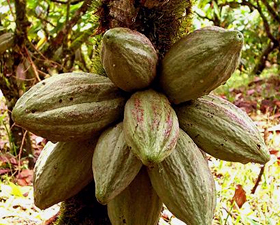
Theobroma cacao, or the cacao tree, grows pod-shaped fruit, also known as cabosses (cabosse is French for pod). Inside the pod is white fruit and seeds, which are dried and fermented into cacao beans (or cocoa beans, if you insist). Photo courtesy of Dagoba Chocolate. |
- The word chocolate should be reserved for the product that is manufactured from the cacao bean—the final product plus the chocolate mass (chocolate liquor) used to produce it. Thus, there are no chocolate trees and chocolate beans, except in children’s stories.
Now that you’ve had a chocolate lesson, you deserve your reward. Order a few bags of Kakawa Cocoa Beans. It’s O.K. that they’re not called Kakawa Cacao Beans. That would be a redundant mouthful—and the mouthful is better spent munching the beans.
— Karen Hochman
FORWARD THIS NIBBLE to anyone who loves serious chocolate, or gives gifts to people who do.
COCOA PURO
Kakawa Cocoa Beans
- 12-Ounce Bag
$28.00
With Shipping
$36.95
Buy online at CocoaPuro.com
While the cocoa beans are sold in an airtight, resealable bag, for more elegant gift-giving you can give them along with a covered glass candy dish or interesting airtight container that becomes the “permanent gift” after the beans are gone (which could be pretty quickly).
Prices and product availability are verified at publication but are subject to change.
Back to Index |
 |
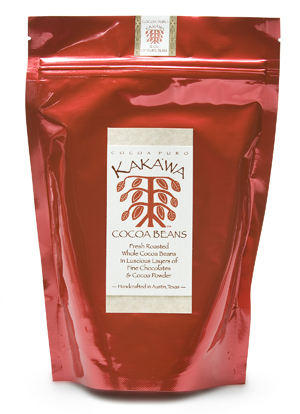
|
Read more about our favorite
chocolates and related products:
|
Check Out These Other “Top Pick Of The Week” Chocolates:
|
Do you have friends who would enjoy THE NIBBLE?
Click here to send them an invitation for the Top Pick Of The Week newsletter. |
ABOUT THE NIBBLE. THE NIBBLE™, Great Food Finds™, is an online magazine plus newsletters about specialty foods and the gourmet life. It is the only consumer publication and website that focuses on reviewing the best specialty foods and beverages, in every category. The magazine also covers tabletop items, gourmet housewares, and other areas of interest to people who love fine food.
© Copyright 2004-2025 Lifestyle Direct, Inc. All rights
reserved. All information contained herein is subject to change at any time
without notice. All details must be directly confirmed with manufacturers, service
establishments and other third parties. The material in this e-zine may not
be reproduced, distributed, transmitted, cached, or otherwise used, except with
the prior written permission of Lifestyle Direct, Inc.
|
 |
|
 |